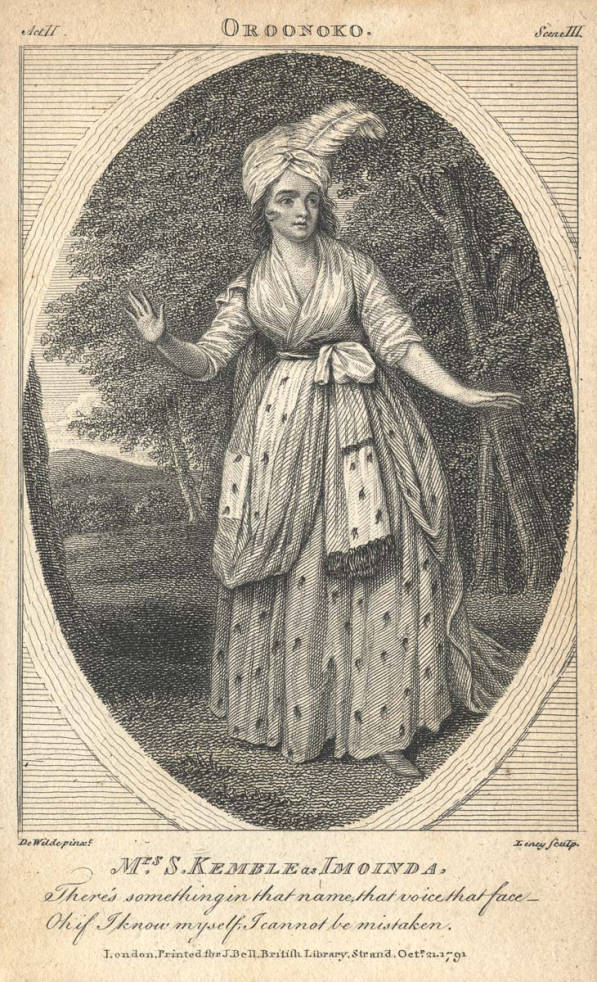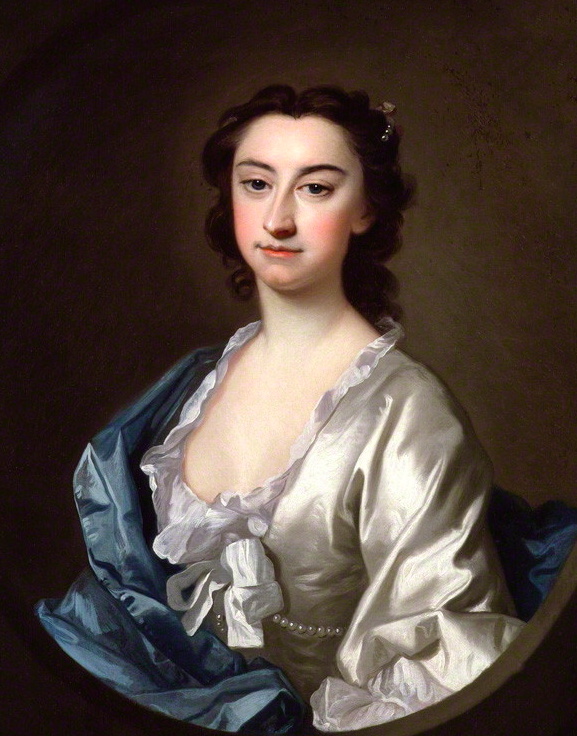|
Elizabeth Satchell
Elizabeth Kemble (née Satchell; 1763 – 20 January 1841) was an English actress. Life She was born in London, and she was a talented performer when she married Stephen Kemble, of the Kemble family, in 1783. They acted together for several years both in London and in the provincial circuits. She outlived him by 19 years. Her most famous role was Yarico from the opera Inkle and Yarico for which she was considered "universally" to be the best "ever seen". She died near Durham. Reputation Theatre manager Tate Wilkinson declared that next to Susannah Maria Cibber, Elizabeth Satchell was the best Ophelia he ever saw. The editor of ''Blackwood's Magazine'' reported:"In all the parts she played she was impassioned; and all good judges who remember her will agree with us in thinking that she was an actress, not only of talent but of genius." James Boaden James Boaden (23 May 1762 – 16 February 1839) was an English biographer, dramatist, and journalist. Biographer He was the ... [...More Info...] [...Related Items...] OR: [Wikipedia] [Google] [Baidu] |
James Boaden
James Boaden (23 May 1762 – 16 February 1839) was an English biographer, dramatist, and journalist. Biographer He was the son of William Boaden, a merchant in the Russia trade. He was born at Whitehaven, Cumberland, on 23 May 1762, and at an early age came with his parents to London, where he was educated for commerce. After serving some time in a counting-house, he turned his attention to journalism, and in 1789 was appointed editor of the ''Oracle'' newspaper, which had been started in that year as a rival to the ''World''. Boaden entered himself at the Middle Temple, but does not appear to have been called to the bar. He died on 16 February 1839. Dramatic works Boaden's first dramatic piece was ''Osmyn and Daraxa, a Musical Romance'', acted in 1793. His next play, ''Fontainville Forest'', 1794, founded on Ann Radcliffe's '' Romance of the Forest'', was received with applause at Covent Garden. From 1795 to 1803 he continued to write plays which were well received: ''T ... [...More Info...] [...Related Items...] OR: [Wikipedia] [Google] [Baidu] |
19th-century English Actresses
The 19th (nineteenth) century began on 1 January 1801 ( MDCCCI), and ended on 31 December 1900 ( MCM). The 19th century was the ninth century of the 2nd millennium. The 19th century was characterized by vast social upheaval. Slavery was abolished in much of Europe and the Americas. The First Industrial Revolution, though it began in the late 18th century, expanding beyond its British homeland for the first time during this century, particularly remaking the economies and societies of the Low Countries, the Rhineland, Northern Italy, and the Northeastern United States. A few decades later, the Second Industrial Revolution led to ever more massive urbanization and much higher levels of productivity, profit, and prosperity, a pattern that continued into the 20th century. The Islamic gunpowder empires fell into decline and European imperialism brought much of South Asia, Southeast Asia, and almost all of Africa under colonial rule. It was also marked by the collapse of the la ... [...More Info...] [...Related Items...] OR: [Wikipedia] [Google] [Baidu] |
18th-century English Actresses
The 18th century lasted from January 1, 1701 ( MDCCI) to December 31, 1800 ( MDCCC). During the 18th century, elements of Enlightenment thinking culminated in the American, French, and Haitian Revolutions. During the century, slave trading and human trafficking expanded across the shores of the Atlantic, while declining in Russia, China, and Korea. Revolutions began to challenge the legitimacy of monarchical and aristocratic power structures, including the structures and beliefs that supported slavery. The Industrial Revolution began during mid-century, leading to radical changes in human society and the environment. Western historians have occasionally defined the 18th century otherwise for the purposes of their work. For example, the "short" 18th century may be defined as 1715–1789, denoting the period of time between the death of Louis XIV of France and the start of the French Revolution, with an emphasis on directly interconnected events. To historians who expand t ... [...More Info...] [...Related Items...] OR: [Wikipedia] [Google] [Baidu] |
1841 Deaths
Events January–March * January 20 – Charles Elliot of the United Kingdom, and Qishan of the Qing dynasty, agree to the Convention of Chuenpi. * January 26 – Britain occupies Hong Kong. Later in the year, the first census of the island records a population of about 7,500. * January 27 – The active volcano Mount Erebus in Antarctica is discovered, and named by James Clark Ross. * January 28 – Ross discovers the "Victoria Barrier", later known as the Ross Ice Shelf. On the same voyage, he discovers the Ross Sea, Victoria Land and Mount Terror. * January 30 – A fire ruins and destroys two-thirds of the villa (modern-day city) of Mayagüez, Puerto Rico. * February 4 – First known reference to Groundhog Day in North America, in the diary of a James Morris. * February 10 – The Act of Union (''British North America Act'', 1840) is proclaimed in Canada. * February 11 – The two colonies of the Canadas are merged, into the United Province of Canada. * Febru ... [...More Info...] [...Related Items...] OR: [Wikipedia] [Google] [Baidu] |
1763 Births
Events January–March * January 27 – The seat of colonial administration in the Viceroyalty of Brazil is moved from Salvador to Rio de Janeiro. * February 1 – The Royal Colony of North Carolina officially creates Mecklenburg County from the western portion of Anson County. The county is named for Queen Charlotte of Mecklenburg-Strelitz, who married George III of the United Kingdom in 1761. * February 10 – Seven Years' War – French and Indian War: The Treaty of Paris ends the war, and France cedes Canada (New France) to Great Britain. * February 15 – The Treaty of Hubertusburg puts an end to the Seven Years' War between Prussia and Austria, and their allies France and Russia. * February 23 – The Berbice Slave Uprising starts in the former Dutch colony of Berbice. * March 1 – Charles Townshend becomes President of the Board of Trade in the British government. April–June * April 6 – The Théâtre du Palais-R ... [...More Info...] [...Related Items...] OR: [Wikipedia] [Google] [Baidu] |
Dictionary Of National Biography
The ''Dictionary of National Biography'' (''DNB'') is a standard work of reference on notable figures from British history, published since 1885. The updated ''Oxford Dictionary of National Biography'' (''ODNB'') was published on 23 September 2004 in 60 volumes and online, with 50,113 biographical articles covering 54,922 lives. First series Hoping to emulate national biographical collections published elsewhere in Europe, such as the ''Allgemeine Deutsche Biographie'' (1875), in 1882 the publisher George Smith (1824–1901), of Smith, Elder & Co., planned a universal dictionary that would include biographical entries on individuals from world history. He approached Leslie Stephen, then editor of the ''Cornhill Magazine'', owned by Smith, to become the editor. Stephen persuaded Smith that the work should focus only on subjects from the United Kingdom and its present and former colonies. An early working title was the ''Biographia Britannica'', the name of an earlier eighteen ... [...More Info...] [...Related Items...] OR: [Wikipedia] [Google] [Baidu] |
Blackwood's Magazine
''Blackwood's Magazine'' was a British magazine and miscellany printed between 1817 and 1980. It was founded by the publisher William Blackwood and was originally called the ''Edinburgh Monthly Magazine''. The first number appeared in April 1817 under the editorship of Thomas Pringle and James Cleghorn. The journal was unsuccessful and Blackwood fired Pringle and Cleghorn and relaunched the journal as ''Blackwood's Edinburgh Magazine'' under his own editorship. The journal eventually adopted the shorter name and from the relaunch often referred to itself as ''Maga''. The title page bore the image of George Buchanan, a 16th-century Scottish historian, religious and political thinker. Description ''Blackwood's'' was conceived as a rival to the Whig-supporting '' Edinburgh Review.'' Compared to the rather staid tone of ''The Quarterly Review'', the other main Tory work, ''Maga'' was ferocious and combative. This is due primarily to the work of its principal writer John Wilson, who ... [...More Info...] [...Related Items...] OR: [Wikipedia] [Google] [Baidu] |
Stephen Kemble
George Stephen Kemble (21 April 1758 – 5 June 1822) was a successful English theatre manager, actor, and writer, and a member of the famous Kemble family. He was described as "the best Sir John Falstaff which the British stage ever saw" though he also played title roles in Hamlet and King Lear among others. He published plays, poetry and non-fiction. Kemble wed prominent actress Elizabeth Satchell (1783). His niece was the actress and abolitionist Fanny Kemble. Early life and family He was born in Kington, Herefordshire, one of 13 siblings and the second son of Roger Kemble and Sarah "Sally" Ward. His siblings included Charles Kemble, John Philip Kemble and Sarah Siddons. He and his brothers were raised in their father's Catholic faith; his sisters were raised in their mother's Protestant faith. His daughter Frances Kemble was a music composer who was a favourite of Sir Walter Scott. She married Capt. Robert Arkwright., son of Richard Arkwright Jr. Kemble's son Henry was ... [...More Info...] [...Related Items...] OR: [Wikipedia] [Google] [Baidu] |
Ophelia
Ophelia () is a character in William Shakespeare's drama ''Hamlet'' (1599–1601). She is a young noblewoman of Denmark, the daughter of Polonius, sister of Laertes and potential wife of Prince Hamlet, who, due to Hamlet's actions, ends up in a state of madness that ultimately leads to her drowning. Along with Queen Gertrude, Ophelia is one of only two female characters in the original play. Name Like most characters in ''Hamlet'', Ophelia's name is not Danish. It first appeared in Jacopo Sannazaro's 1504 poem '' Arcadia'' (as ''Ofelia''), probably derived from Ancient Greek ὠφέλεια (''ōphéleia'', "benefit"). Plot In Ophelia's first speaking appearance in the play, she is seen with her brother, Laertes, who is leaving for France. Laertes warns her that Hamlet, the heir to the throne of Denmark, does not have the freedom to marry whomever he wants. Ophelia's father, Polonius, who enters while Laertes is leaving, also forbids Ophelia from pursuing Hamlet, as Poloni ... [...More Info...] [...Related Items...] OR: [Wikipedia] [Google] [Baidu] |
Susannah Maria Cibber
Susannah Maria Cibber (née Arne; February 1714 – 30 January 1766) was a celebrated English singer and actress. She was the sister of the composer Thomas Arne. Although she began her career as a soprano, her voice lowered in the early part of her career to that of a true contralto. She was universally admired for her ability to move her audiences emotionally both as an actress and vocalist. Possessing a sweet, expressive, and agile singing voice with a wide vocal range, Cibber was an immensely popular singer, even if at times her voice was criticized for a lack of polished technique. Charles Burney wrote of her singing that "by a natural pathos, and perfect conception of the words, she often penetrated the heart, when others, with infinitely greater voice and skill, could only reach the ear." Cibber was particularly admired by Handel, who wrote numerous parts especially for her including the contralto arias in his 1741 oratorio ''Messiah'', the role of Micah in ''Samson'', the r ... [...More Info...] [...Related Items...] OR: [Wikipedia] [Google] [Baidu] |





